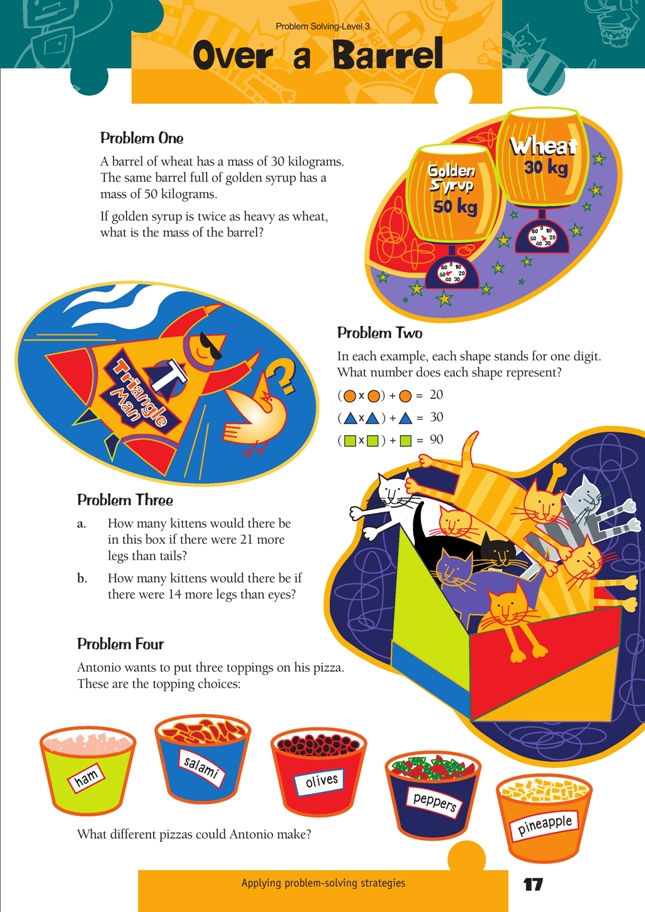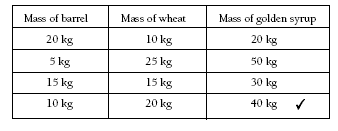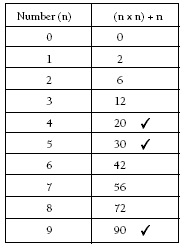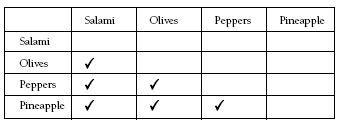These are level 3 algebra and statistics problems from the Figure It Out series.
A PDF of the student activity is included.
Click on the image to enlarge it. Click again to close. Download PDF (157 KB)
solve equations involving symbols (Problem 2)
find outcomes using diagrams (Problem 4)
Problem One
Students may solve the problem by trial and improvement. This will involve trying numbers for the mass of the barrel and seeing if the resulting masses for wheat and golden syrup work.
The mass of 10 kilograms for the barrel works because the mass of the golden syrup is twice the mass of wheat.
Another way to solve the problem is to use logical reasoning. If golden syrup is twice as heavy as wheat, this collection of barrels would have the same mass:
A barrel of golden syrup has a mass of 50 kilograms, and a barrel of wheat has a mass of 30 kilograms, so this can be represented as:
+ 50 = 30 + 30 where is the mass of an empty barrel.
So + 50 = 60
So = 10
Problem Two
Students should realise that because each equation involves multiplication of a number by itself and the answers are less than 100,must be less than 10.
They can then solve each equation by trial and improvement or by eliminating all the possibilities:
The numbers in the right-hand column show a pattern of differences that provides an interesting extension:
Problem Three
This problem is similar to Problem One on this page because it involves possibilities (that is, the number of kittens) and a constraint (there are 21 more legs than tails).
As with Problem One, students could use trial and improvement. However, a more efficient method might be to realise that each kitten has three more legs than tails (4 – 1 = 3). To get 21 more legs than tails would require seven kittens because 7 x 3 = 21.
Similarly, a kitten has two more legs than eyes, so 14 more legs than eyes means seven kittens as well because 7 x 2 = 14.
Problem Four
Combinations such as this can be solved in a variety of ways (see the notes on probability,
Answers and Teachers’ Notes: Statistics, Figure It Out, Level 3). These include:
• An organised list:
All possibilites with ham:
ham – salami – olives
ham – salami – peppers
ham – salami – pineapple
ham – olives – peppers
ham – olives – pineapple
ham – peppers – pineapple
All possibilities with salami but no ham:
salami – olives – peppers
salami – olives – pineapple
salami – peppers – pineapple
Remaining possibility
olives – peppers – pineapple
• A tree diagram:.gif)
• Tables:
Ham with …
Salami with …
Olives with …
Answers to Problems
1. 10 kg
2. The circle represents 4, the triangle represents 5,
and the square represents 9.
3. a. 7
b. 7
4. There are 10 different pizzas that could be made:
ham – salami – olives
ham – salami – peppers
ham – salami – pineapple
ham – olives – peppers
ham – olives – pineapple
ham – peppers – pineapple
salami – olives – peppers
salami – olives – pineapple
salami – peppers – pineapple
olives – peppers – pineapple







